#love letters of portuguese nun
Text

Susan Hemingway and Ana Zanatti in Die Liebesbriefe einer portugiesischen Nonne (1977)
AKA Love Letters of a Portuguese Nun
#die liebesbriefe einer portugiesischen nonne#love letters of portuguese nun#susan hemingway#ana zanatti#1970s horror#1970s movies#1977#jesús franco#drama#horror#nunsploitation
110 notes
·
View notes
Text
15 Questions: Character Edition
Tagged by @words-after-midnight! Using this for OCs as well as writers is a fun idea.
Going with everyone's favorite repentant bloodborn and fish dad, Renato (who just got some lovely new art):
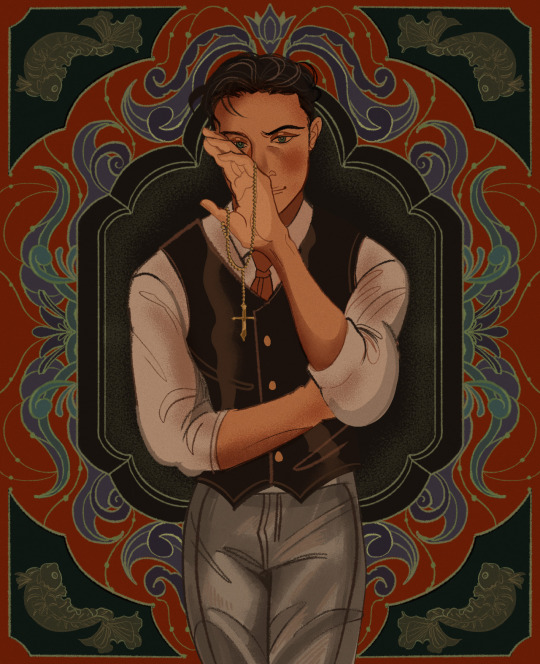
(Thank you again to @littlestpersimmon for taking the commission! I love the background and fish details especially. Go check out more of Caleb's beautiful art and comics if you're not familiar with them already!)
1. Are you named after anyone? My given name came from my great grandmother on the Dimas side of the family, my father's side. I chose "Renato" as a teenager because the meaning (reborn) applied to both my transition and future as a bloodborn. Anyway, it shares the first letter and same number of syllables with the old one, so I also just liked how it sounded.
2. When was the last time you cried? I...honestly can't remember. Really. I'm not trying to sound tough or cool or anything. I must've cried when I was still a child of course, before the break. I can recall afterwards, though, watching the harbor get farther and farther away as my family fled the destruction on a ship. My eyes were completely dry. I still felt...still feel despair, anger, sadness. But after the world changed, I did too. Crying just seemed like a waste of water. It wouldn't get me anything, so my body just...didn't bother with tears.
*shifts, visibly nervous* But I think...I think I'd like to cry again someday? Is that a strange thing to say? Nevermind--forget it. Next question.
3. Do you have kids? No, but I have the next best thing. *opens wallet with photos* The goldfish is Tesoro--Tes, for short. They can roll a tiny football into a mini net. Ah, they're so talented! Then there's Beija, the pleco. She's nocturnal like me, but rather shy. And of course I can't forget the Venerable Order of Lady Guppies: Sisters Dolores, Joan, Hildegard, Leonella, Mary Celeste, Teresa, and Abbess Malfada. They're named after nuns since there aren't any male guppies in the tank and, well, you get the idea.
4. Do you use sarcasm? Occasionally, to make a point maybe. I prefer saying something outrageous with a serious face, though. I've gotten quite good at it over the years.
5. What's the first thing you notice about people? It's going to sound terrible...it is terrible, but true. I try to see if they have a weapon, and assess their vulnerable points, gauge which would be best to strike first. You know...to incapacitate. Or kill, if need be. It's ingrained into you as part of becoming an aquila. But I'm sure you don't want to listen to such a dark subject.
6. What's your eye color? *sighs* They're blue-green, or aquamarine, or sea-green, or whatever you want to call them. I honestly don't find them that special. The way dark brown or black eyes shine is much more appealing, in my opinion.
7. Scary movies or happy endings? Hm. I'm just as likely to be annoying and complain about either one being unrealistic. I think the execution and style is what matters to me, not the category.
8. Any special talents? Winning people's trust. Being deserving of it... that's another matter. I've been told I pick up languages rather quickly, at least as far as basic conversation goes. Of course I grew up being a strong swimmer and diver.
9. Where were you born? On the Pacific, in a ship's medical bay, while my mother was accompanying my father to the States. That meant I was a default Portuguese citizen, although I have dual citizenship now.
10. What are your hobbies? Looking after my fish, making a nuisance of myself, finding what little pleasures I can take. I'm starting to realize just how much of my identity was tied to being an aquila, honestly. Without that...well, I suppose I'll just have to test things out and see what sticks.
11. Have you any pets? Oh, do you want to watch all my videos of Tes and the others? [A/N: I advise you to decline. There are a lot of fish videos.]
12. What sports do you/have you played? I practice various styles of fighting and marksmanship, but that's survival rather than friendly competition. I never had a real opportunity to play any, given the world descended into chaos when I was ten. I mean, Ollie and I used to play a game where we'd dare each other to touch sharks while scavenging. Does that count?
13. How tall are you? 5'6". Many of the deadliest predators are smaller than their prey.
14. Favorite subject in school? I only attended about five years of Catholic school. My parents found me tutors for various subjects after the break happened. I did fine with math, reading, science, all of that, but I preferred learning and honing skills. Spear fishing, sailing, foraging, those sorts of things I could use in a practical sense.
15. Dream job? *grins* Indolent concubine of a lofty noble or conquering warlord (gender neutral). Let me know if you hear about any openings. [A/N: He doesn't know about the fantasy realm right next door to Earth, or the mind worms. Not yet.]
Tagging the Dysthanasia taglist: @thecyrulik @cljordan-imperium @k--havok as well as @vacantgodling @menagerie-of-monsters @calicojackofficial @afoolandathief an open one for anyone who wants to do this
17 notes
·
View notes
Photo

Singing AND smiling.
Julieta Serrano as Madre Superiora in "Entre tinieblas" (1983) ("Dark Habits" in English somehow.)
The nun is far from a saint, but she’s glowing (as if halo above head.) Lesbian in love, this is why :D :D :D
For the application users: the gif is 300 px wide.
(Not related, but in the song Julieta sings with chiado ([shiadu] if use English transcription) where S in the end of words turns into [sh]. El idioma español = castellano has no shiado. But no, she wasn’t using Portuguese of neighbouring country. She’s from Catalunya (Cataluña \ Catalonia) & a site with "pronunciació català" explains sounds. Siii, S —> [sh] at least in the end of words. It’s known that the character moved to Madrid, so she could be from Catalunya.)
Edit: Actually it's not chiado exactly. A Reddit comment "says" that S català is heard as [sh] for non-native speakers, but it's much softer than [sh] for the letter X.
#lesbian#Entre tinieblas#Julieta Serrano#gif#nun#my gif#transgression gif as a gift to myself for 11 years on Tumblr
6 notes
·
View notes
Text
Congregation of the priests of the sacred heart


During the first ten centuries of Christianity, there is nothing to indicate that any worship was rendered to the wounded Heart of Jesus. Historically the devotion to the Sacred Heart is an outgrowth of devotion to what is believed to be Christ's sacred humanity. Sacred Heart of Jesus, Portuguese painting from the 19th century.
13.2.4 Sacred Heart Enthronement Network.

13.2.2 The National Enthronement Center.
Mateo Crawley-Boevey, Apostle of The Enthronement of the Sacred Heart
13.2 Spreading the Devotion to the Sacred Heart of Jesus in the 20th-Century.
13.1 Act of enthroning the Sacred Heart in a home or other place.
13 Enthronement of the Sacred Heart of Jesus.
8 Promises of the Sacred Heart of Jesus.
Predecessors to the modern devotion arose unmistakably in the Middle Ages in various facets of Catholic mysticism, particularly with Gertrude the Great. The popularization of this devotion in its modern form is derived from a Roman Catholic nun from France, Margaret Mary Alacoque, who said she learned the devotion from Jesus during a series of apparitions to her between 16, and later, in the 19th century, from the mystical revelations of another Catholic nun in Portugal, Mary of the Divine Heart, a religious sister of the congregation of the Good Shepherd, who requested in the name of Christ that Pope Leo XIII consecrate the entire world to the Sacred Heart of Jesus. The devotion is especially concerned with what the church deems to be the long-suffering love and compassion of the heart of Christ towards humanity. The 12 promises of the Most Sacred Heart of Jesus are also extremely popular. In the Latin Church, the liturgical Solemnity of the Most Sacred Heart of Jesus is celebrated the third Friday after Pentecost. This devotion to Christ is predominantly used in the Catholic Church, followed by high-church Anglicans, Lutherans and some Western Rite Orthodox. The Sacred Heart, also known as the Most Sacred Heart of Jesus ( Sacratissimum Cor Iesu in Latin), is one of the most widely practised and well-known Catholic devotions, wherein the heart of Jesus is viewed as a symbol of "God's boundless and passionate love for mankind". This is an off-reservation boarding school for grades K-8 that serves largely Lakota students.True Bodily and Spiritual Enlightenment of the Sacred Heart of Jesus (picture in the Church of Saint-Gervais-et-Saint-Protais, Paris, France) Joseph's Indian School in Chamberlain, South Dakota since 1927. There it also operates the Sacred Heart School of Theology, the largest seminary in the United States for men over the age of 30 who are preparing for the priesthood.Īmong other facilities, the Institute owns and operates St. In the United States, it is based in Hales Corners, Wisconsin. Carlos Luis Suarez Codorniú is the current superior general. The congregation is present in over 40 countries on five continents (Europe, Africa, North and South America and Asia). The institute was founded in northern France in Saint-Quentin, Aisne, Picardy by Léon Dehon (Leo John Dehon) in 1878, and has become international. This name comes from the name of the Congregation's founder, the Venerable Fr. In most of the rest of the world, members are known as Dehonians. In the Philippines and North America, members are referred to as the SCJs. SCJ comes from the Latin name of the Congregation, Congregatio Sacerdotum a Sacro Corde Iesu. after their names to indicate their membership in the Congregation. The members of the Congregation add the nominal letters S.C.J. The Congregation of the Priests of the Sacred Heart (Latin: Congregatio Sacerdotum a Sacro Corde Iesu), also known as Dehonians in reference to their founder, Leo John Dehon, is a Roman Catholic clerical religious congregation of Pontifical Right for men (lay brothers and priests) who live, pray and work together.

Congregation of the Priests of the Sacred HeartĬongregatio Sacerdotum a Sacro Corde Iesu

0 notes
Photo






DIE LIEBESBRIEFE EINER PORTUGESISCHEN NONNE (Love letters of a Portuguese nun) (1977), directed by Jesús Franco.
34 notes
·
View notes
Photo

Love Letters of a Portuguese Nun (1977)
It’s Franco Friday!
#Love Letters of a Portuguese Nun#Die Liebesbriefe einer portugiesischen Nonne#Jesús Franco#Jess Franco#Mariana Alcoforado#nunsploitation#Letters of a Portuguese Nun#Love Letters from a Portuguese Nun#exploitation film#exploitation#convent#nuns#nun#Inquisition-era#70s#Susan Hemingway#William Berger#Ana Zanatti#gif#gifs#my gif#my gifs#Franco Friday#Jess Franco Friday#Jesús Franco#horror movie#horror film#horror cinema#horror#cult
21 notes
·
View notes
Photo



Love Letters of a Portuguese Nun (1977)
#die liebesbriefe einer portugiesischen nonne#love letters of a portuguese nun#movies#jesús franco#caps#1970s#nuns
32 notes
·
View notes
Text

Jess Franco Friday!
#love letters of a portuguese nun#jess franco#jess franco friday#franco friday#nunsploitation#gif#grindhousecellar
26 notes
·
View notes
Photo







Love Letters of a Portuguese Nun (1977) dir. Jesús Franco
36 notes
·
View notes
Text

Susan Hemingway and Ana Zanatti in Die Liebesbriefe einer portugiesischen Nonne (1977)
AKA Love Letters of a Portuguese Nun
#die liebesbriefe einer portugiesischen nonne#love letters of portuguese nun#susan hemingway#ana zanatti#1970s horror#1970s movies#1977#jesús franco#drama#horror#nunsploitation
63 notes
·
View notes
Text

die liebesbriefe einer portugesischen nonne / love letters of a portuguese nun (1977)
11 notes
·
View notes
Text
10 incredible women in history you should know

Shutterstock
A few years ago, I began to notice that the people I taught about in my World History classes were, more often than not, European men.
When women were included in the state curriculum, they felt like token inclusions who were often related to men and discussed in proximity to them; not as independent actors. They were often queens or empresses, and only a few women of “normal” status made our lessons. I began the work of analyzing my World History lessons to make them more inclusive and diverse. I found that by including women with different backgrounds, fields, and from different parts of the world, I could provide students with role models they could identify with, and remind male students that women are capable of greatness too.
Here’s some additional good news: we don’t need to carve out a single month, special lesson, or unit, to incorporate women into our lessons. First, when planning, I ensure that I include women next to their male colleagues in all my materials. Then, when executing the lessons, I tell these women’s stories in as well-rounded a way as possible because it’s not just who we teach about— it’s how we approach their story that can give it power.
For example, when I teach about Cleopatra, I don’t just talk about her in relation to Julius Caesar or Marc Antony— I spend time discussing how she was a linguist, and the first Greek of the Ptolemaic line ruling Egypt who learned to speak Egyptian; she was a scholar and a woman who understood her people. When I teach about women like the Empress Josephine or Marie Antoinette, I discuss their emotions, letters, relationships, and struggles in unhappy marriages.
In all narratives that we share, male and female alike, we have the opportunity to humanize history, to make people on pages relatable by talking about their emotions, their mental health, and their experiences. When we bring them to life for students, we draw students into history.
I polled my students, past and present, to ask them which figures they remember most, and I have included some of their favorites as well my own. Here are 10 amazing women you should know and share, from the 300s CE to the 1900s CE:
1. Hypatia (c. 370 CE – March 415 CE) – Ancient Rome

Hypatia of Alexandria was a philosopher, mathematician, and teacher, born in Alexandria, Egypt around 370 CE, just before Christianity became the official religion of the Roman Empire. She was the daughter of a mathematician who taught her math and astronomy, and trained her in Neo-Platonic philosophy. She joined her father as a teacher at the University of Alexandria, and was a beloved teacher who fostered an open environment, teaching pagans, Jews, and Christians.
Both her presence as a female teacher and her insistence on an accepting classroom in an increasingly hostile religious atmosphere of early Christian Rome made her courses unusual and that much more coveted. She was widely known for her love of learning and expertise, but in 415 CE, due to her high profile and power as a non-Christian woman, she was targeted by a mob of Christian monks who killed her in the streets. They then also burned the University of Alexandria, forcing the artists, philosophers, and intellectuals to flee the city. Hypatia’s life models open-mindedness, generosity, and a love of learning, and her death is often discussed as a watershed turning point in the Classical world.
Topics you can connect her to in history include the connections between Roman and Greek philosophy, and the rise of Christianity in the Roman Empire. Students have loved learning about a woman who taught in such an open-minded way, and learning she is one of my role models too.
2. Empress Theodora (c. 497 – c. 548) – The Byzantine Empire

The Byzantine Empress Theodora was born into a circus family in Constantinople, just after the fall of the Western Roman Empire. Her father likely worked as a bear trainer in the Hippodrome, and a young Theodora, it was said, took work as an actress and dancer. The Byzantine Emperor Justinian encountered her one day and, taken by her beauty, determined to marry her. However, because she was a commoner and had a bit of a reputation, special laws had to be passed in order for them to marry.
Though she never technically co-ruled the empire with Justinian, she had significant influence and power, and was a trusted advisor who promoted religious and social policies, many of which benefited women. Some of which included altering divorce laws and prohibiting the traffic of young women. Her name was listed in nearly all laws passed, she had regular communication with other foreign rulers, and received foreign envoys. Empress Theodora is credited with helping stabilize Justinian’s power after she urged him to stand his ground during the Nika revolt of 532 CE.
Topics you can connect her to in history include the Byzantine Empire, naturally, and students have told me they love her backstory and how she fought for women’s rights. They also enjoy how she pushed Justinian to make him a better ruler.
3. Sappho of Lesbos (c. 620 – c. 570 BCE) – Ancient Greece
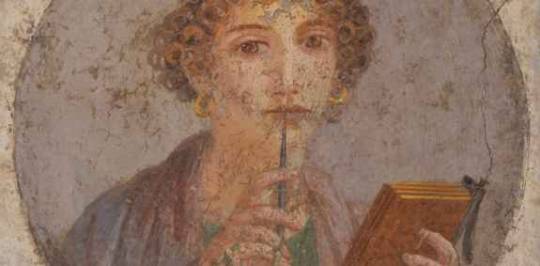
Sappho of Lesbos was a lyric poet of Ancient Greece who was so famous during her life that statues were created in her honor. She was praised by Plato and other Greek writers, and her peers referred to her as the “Tenth Muse” and “The Poetess.” Very few fragments of her work survived because she wrote in a very specific dialect, Aeolic Greek, which was difficult for later Latin writers to translate.
Her poetry was lyric poetry – to be accompanied by the lyre – and was sung frequently at the parties of high-ranking Greeks. She wrote about passion, loss, and deep human emotions. Some of her surviving poems imply she may have had romantic relationships with women, and thus from her name we get the etymology of “lesbians” and “sapphic.”
Topics you can connect her to in history include the ancient Greeks and Greek philosophy and art. Every year, I have female students who have told me that they valued her inclusion because it was the first time they had heard about an LGBTQ+ person in their history class, and the representation meant so much to them.
4. Margery Kempe (c. 1373 – c. 1440 CE) – Middle Ages Europe

Margery Kempe was an English mystic and traveler, and is also the author of the first autobiography in the English language. She was the mother to 14 children. After her first child was born, Margery had a traumatic postpartum experience of a form of psychosis; for months she was catatonic, experiencing visions, and was tied to her bed for her own safety. For the rest of her life she would experience these visions, and later on she would leave her family and travel on pilgrimages to Spain, Jerusalem, Rome, and Germany.
Margery was known to weep loudly at various shrines and this behavior did not endear her to leaders in the church. She also insisted on wearing white like a nun, seeking specific permission to do so. She narrated her life and travels upon her return to two clerks who wrote it down on her behalf, so it is a unique book in that it shares her very specific life experiences in her own voice. Margery is a conflicting person to teach about because of her mysticism: do we discuss her experiences and travels through the lens of religion, or mental health? Historians often opt for both, as we seek to understand her contributions and life.
Topics you can connect her to in history include Christianity, the Middle Ages in Europe, and travel narratives like those of Marco Polo and Ibn Battuta. My students remember Margery fondly, and she makes their list of favorites consistently. They like how we talk about her through the lens of mental health and that she pursued what she believed despite naysayers.
5. Njinga of Ndongo and Matamba (c. 1581 – c. 1663 CE) – Post-Classical Africa

Njinga Mbandi was a warrior queen of modern Angola. She was born to a concubine of the king of Ndongo and as a daughter, it was unlikely she would take the throne, so her father allowed her to attend many of his important meetings and negotiations, and also allowed her to be trained as a warrior and educated fully. When her half-brother took the throne after their father’s death, he had her infant son killed and Njinga fled to nearby Matamba, but returned when her brother begged her to negotiate on behalf of her people with the rapidly encroaching Portuguese. Njinga did so successfully, due to her notably diplomatic skills and her insistence on respect from the Portuguese, going so far as to refuse to sit lower than them during the negotiations. She won significant concessions from the Portuguese.
When her brother died, Njinga took the throne; at various points during her reign, Njinga was deposed, regained power, lost territory, and gained it. She struggled against the Portuguese to maintain her peoples’ independence. Ultimately, when Njinga died at the age of 81, she left behind a stable kingdom that would be led by women for the majority of the next 100 years. While Ndongo was eventually taken by the Portuguese, Matamba maintained its independence through the 1900s.
Topics you can connect her to in history include Africa and the age of European exploration, as well as African resistance to Europeans. I think it’s important that we show examples of successful resistance and a powerful legacy.
6. Artemisia Gentileschi (c. 1593 – c. 1654) – Renaissance Europe
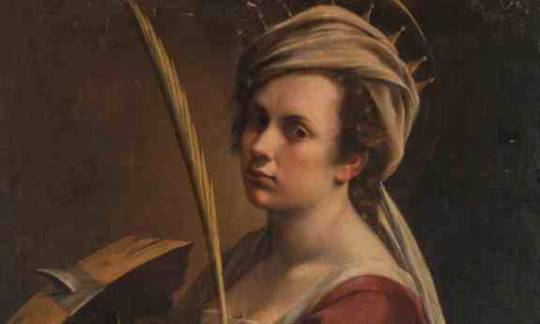
Artemisia Gentileschi was born in Rome to a gifted painter. Her father trained her to paint and even hired a tutor for her; ultimately this ended in tragedy, as the tutor raped Artemisia. There was a horrific trial and Artemisia was tortured with thumbscrews for “the truth.” Artemisia left for Florence, had a family, and was the first woman to gain membership to the Academy of the Arts of Drawing. She went back to paint in Rome for a time, as well as London where she painted in the court of Charles I, and then settled in Naples.
While in Florence, she painted for Michelangelo the Younger in the Casa Buonoratti, and was paid more than her male peers for her time and efforts. Artemisia’s work is profound, passionate, unabashed, and reclaims the space of women in the stories told about them. She makes women her focal points, her heroines, and paints them in positions of strength, and often revenge.
A topic you can connect her to in history is of course the Renaissance. Artemisia has stuck for many of my female students who have experienced sexual assault or harassment. They have expressed to me that they are inspired by her strength and find solace in her paintings. One of my students even went on to do her senior capstone all about Artemisia, two years after taking my class.
7. Malintzin/Malinche/Doña Marina (c. 1500 – c. 1550) – Colonial Americas
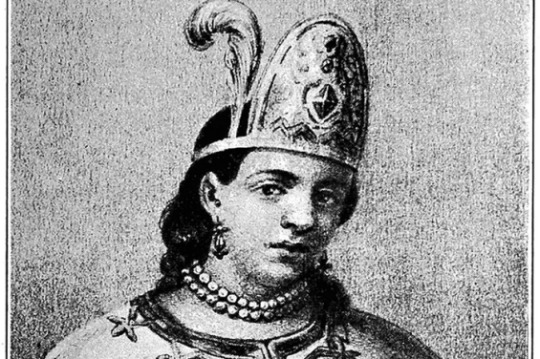
Born to a local chieftain in Central America and a mother whose family ruled a nearby village, Malintzin (or Malinali, or Malinche) was of high rank on both sides of her family. When her father died and her mother remarried, she was secretly sold into slavery so her brother would inherit the land that was her birthright. Malintzin was sold to several tribes, and over the course of her life would learn to speak Maya, Nahuatl, and later Spanish.
She was eventually given to Hernán Cortés and his men in 1519, and upon realizing her skill as a translator, Cortes came to rely on her. Malinztin was baptised as Doña Marina, and traveled with the Spanish for the next few years as they battled or negotiated with various Indigenous groups in the Aztec Empire. She provided cultural context and insight as well as communication skills. Without her, Spanish success in the region would have been difficult to achieve. By 1521, Cortes had conquered the Aztecs and needed her to help him govern. She was given several pieces of land around Mexico City as a reward.
Topics you can connect her to in history include Spanish conquest of the Americas and Indigenous peoples of the Americas. We talk about her complicated legacy as she is viewed by some as a traitor to her people, and to others as a woman who was enslaved and did the best she could to survive in difficult circumstances. My students typically find her a fascinating and sympathetic figure, a woman who did all she could to survive and thrive in adversity.
8. Olympe de Gouges (May 7, 1748 – November 3, 1793) – Enlightenment Europe

Olympe de Gouges, born Marie Gouze, was a political activist and writer during the French Revolution. Married off against her will at the young age of 16, she renamed herself Olympe de Gouges after her husband’s death and moved to Paris. She pursued her education there and rose to a high status in Parisian society. She would host salons for thinkers of the time and would write poetry, plays, and political pamphlets. De Gouges was a pacifist, an abolitionist, and wanted an end to the death penalty. She wanted a tax plan that allowed wealth to be spread more evenly, with welfare for the less fortunate and protections for women and children.
De Gouges was in favor of the French Revolution, but when the Revolution failed to provide the equality it claimed it would, she grew critical. The Revolution was in many ways built on the backs of women: women were some of the first to march against the king and take up arms and they served on the front lines of France’s battles against other European powers. Yet women were not being provided the true “egalite” promised in terms of rights as citizens.
De Gouges wrote her most famous work in response to this, “The Declaration of the Rights of Women” (1791). It was a direct play on The Declaration of the Rights of Man and the Citizen that was part of the first French Constitution. She became increasingly vocal, and in 1793 she was arrested by the revolutionary government and guillotined.
Topics you can connect with Olympe de Gouges, as well as Mary Wollstonecraft, include Enlightenment writers and the Age of Revolutions; it is unfair for Voltaire and Montesquieu to get all the limelight! Her ideas resonate for my students as being very modern, and they appreciate that she never backed down from her convictions and is a model of courage.
9. Manuela Sáenz (December 27, 1797–November 23, 1856) – Revolutionary Americas

Manuela Sáenz is the illegitimate daughter of a Spanish military officer and an Ecuadorian noblewoman. Her childhood included a traditional education in a convent, as well as learning how to ride and shoot. When she was 17, her father arranged her marriage to an English doctor who was nearly twice her age, James Thorne. She moved with him to Lima, Peru, where she was connected with revolutionaries who were interested in overthrowing the Spanish in Latin America.
She returned to Quito, Ecuador in 1822, and met the revolutionary leader Simón Bolívar. They fell in love and would occasionally live together and go on campaign together. Manuela would go into battle with Bolívar in the cavalry, and was promoted from captain to colonel; she even saved Bolívar from assassination at least twice. She was also given the Order of the Sun, the highest military honor in the revolutionary government. Upon Bolívar’s exile and death in 1830, Manuela had no resources and lived the rest of her life in a small coastal village in Peru, making money by writing letters for sailors, including Herman Melville. She died in a diphtheria outbreak and was buried in a mass grave. Her role in Latin America’s independence has only recently been recognized, and she was granted an Honorary General title in Ecuador in 2007.
Topics you can connect her to in history include Latin American revolutions and the Enlightenment. My students find her time as a soldier and spy endlessly interesting! I enjoy including women, particularly in this period, who went into battle, such as the women of France who fought in the revolutionary wars. I have female JROTC students who like knowing they are part of a long tradition.
10. Lyudmila Pavlichenko (July 12, 1916 – October 27, 1974) – World War II

Lyudmila Pavlichenko was born in Ukraine and was one of the best snipers in history. She pursued sharp shooting when in school and fought for the Red Army of the Soviet Union during World War II as a trained sniper. She soon began to rack up an impressive tally of kills, reaching 309 in just a few months on the frontline.
The German soldiers knew her by name, and she would engage in some of the most dangerous fighting, sniper seeking sniper. She was wounded four times in battle, and in 1942 she took shrapnel in her face.
She was sent to the United States to tour and drum up American support for the war effort, as the USSR and USA were allies at the time and the USSR depended on continued American engagement. She was often frustrated when asked by American journalists about issues around makeup, clothing, or hair. Finally, she spoke during a tour and said “Gentlemen. I am 25-years-old and I have killed 309 fascist occupants by now. Don’t you think, gentlemen, that you have been hiding behind my back for too long?” This was greeted by a roar of applause.
She got to know Eleanor Roosevelt during this tour and they became good friends. Upon her return to the USSR, Pavlichenko was promoted to major, awarded the Gold Star of the Hero of the Soviet Union, and received the Order of Lenin twice. She continued training other Soviet snipers, and then when the war ended, finished her education at Kiev University and became a historian and research assistant for the Soviet Navy.
Topics you can connect her to in history include World War II and the Cold War. Students adore her story: they find her sass, grit, and action movie skills endlessly fascinating.
ABOUT THE AUTHOR
Caitlin Tripp is a teacher and curriculum writer for Atlanta Public Schools. Born and raised in West Africa and Latin America, she loves to travel and learn more about the places she visits. She is passionate about women’s history, and in her free time enjoys snuggling up to a history documentary with her husband and their two cats.
Caitlin Tripp originally shared how to incorporate women into history lessons in her Educator Talk submitted through the TED Masterclass for Education program. To learn more about how TED Masterclass for Education inspires educators to develop their ideas into TED-style Talks, visit https://masterclass.ted.com/educator
10 incredible women in history you should know published first on https://premiumedusite.tumblr.com/rss
4 notes
·
View notes
Text
Queen Philippa and King João I children.
1º: King Duarte

11th Monarch of Portugal. Born in Viseu, October 31, 1391, and died in Tomar, September 9, 1438.
He was crowned king in Leiria, in 1433.
Despite his reign being short, he decreed the Mental Law (a ‘Lei Mental’) – a measure towards centralisation in order to defend the spoils of the crown.
He became involved in government while his father was still alive. In 1412, King João I officialised his association with the governance and included him in its administration.
He was a cultured man with love of letters, owning a library filled with classical authors and thinkers of the Church, as his book The Loyal Counsellor shows.
He also wrote The Art of Riding on Every Saddle.
His reign was marked by the Tangier campaign of October 1437, which resulted in failure and a great defeat for the Portuguese forces.
The consequence of this defeat was having to leave the Infante Fernando as a hostage while Henrique came to Lisbon to present the Moroccans’ terms for a treaty: Portugal handing back Ceuta in exchange for the life of the Infante. As this exchange never took place, the latter earned the name of the Saint Prince, after he died in captivity.
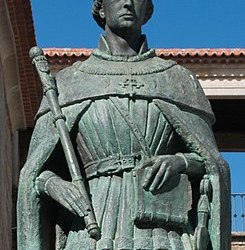
Duarte married Leonor (Eleanor) of Aragon in Coimbra on September 22, 1428 and they had 9 children:
Infante João: Born in October 1429/ Died in August 14th 1433: Prince of Portugal, died young.
Infanta Filipa: Born in November 27th 1430/ Died in March 24th 1439: Died young
Infante Afonso: Born in January 15th 1432/ Died in August 28th 1481: Who succeeded him as Afonso V, King of Portugal;
Infanta Maria: Born in December 7th 1432/ Died in December 8th 1432: Died in infancy;
Infante Fernando: Born in November 17th 1433/ Died in September 18th 1470: Duke of Viseu. He was declared heir to his brother Afonso V for two brief periods, and therefore used the style of Prince instead of Infante. He was the father of future King Manuel I.
Infanta Leonor: Born in September 18th 1434/ Died in September 3rd 1467: Holy Roman Empress by marriage to Frederick III, Holy Roman Emperor;
Infante Duarte: Born in July 12th 1435/ Died in July 12th 1435: Died shortly after being born;
Infanta Catarina: Born in November 26th 1436/ Died in June 16th 1463: She was betrothed to Charles IV of Navarre but he died before the marriage could take place. After his death, Catherine entered the Convent of Saint Claire and became a nun;
Infanta Joana: Born in March 20th 1439/ Died in June 13th 1475: Queen of Castile by marriage to Henry IV of Castile.
He decided to build his own Pantheon at the Monastery of Batalha and it is there that his mortal remains are laid to rest, beside those of his wife. The space is known today as the Unfinished Chapels, being an arrangement of seven chapels destined for King Duarte and his lineage, which, however, were never finished.



He earned the name of The Eloquent, due to his writings, and the motto Léauté Faray Tã ya Serey was also his.
10 notes
·
View notes
Text
La Corda d'Oro and its Saints Part 2: July to December
Here’s the second part of some of the characters from La Corda d'Oro, and here they are!
July 5th - Mari Tsuzuki
St. Anthony Maria Zaccaria: Italian confessor who was an early leader of the Counter Reformation, promoter of the devotion to the Passion of Christ, the Eucharist and the renewal of the religious life among the lay people, and is the founder of the Clerics Regular of St. Paul aka the Barnabites. Canonized as a saint by Pope Leo XIII in 1897, his major shrine can be found at San Paolo convent in Milan.
July 8th - Shiro Hozumi
St. Grimbald (Grimwald): Abbot and confessor from the Benedictine order. Although of dubious historical accuracy, the life of Grimbald was recorded in several volumes, of which the main source is referred to as the Vita Prima of St. Grimbaldi. King Alfred met Grimbald before his reign, and after his coronation invited Grimbald to England around 892. After he died in 901, he was venerated as a saint and confessor, and some altars were dedicated to him. He also figures in a number of legendary tales of Oxford.
July 25th - Ryoutaro Tsuchiura
St. James the Greater: One of the twelve apostles of Christ and is described as one of the first disciples to join Jesus. The Synoptic Gospels state that James and his brother John, were with their father Zebedee, by the seashore when Jesus called them to follow him. He is the first apostle to be martyred at the hands of King Herod Agrippa according to the Acts of the Apostles. The traditional pilgrimage to the grave of the saint, known as the ’Way of St. James’, has been the most popular pilgrimage for Western European Catholics from the Early Middle Ages onwards. An even later tradition states that he miraculously appeared to fight for the Christian army during the legendary battle of Clavijo, and was henceforth called Santiago Matamoros (James the Moor-slayer).
August 21st - Housei Toki
Pope St. Pius X: 257th bishop of Rome who reigned for 11 years, and is known for vigorously opposing modernist interpretations of Catholic doctrine, promoting liturgical reforms and orthodox theology. He directed the production of the 1917 Code of Canon Law, the first comprehensive and systemic work of its kind. He was devoted to the Marian title of Our Lady of Confidence; while his papal encyclical Ad diem illum took on a sense of renewal that was reflected in the motto of his pontificate and he was also advanced the Liturgical Movement as the only Pope to favor the use of the vernacular language in teaching catechesis, he encouraged the frequent reception of holy communion, and he lowered the age for First Communion, which became a lasting innovation of his papacy. After his death, a strong cult of devotion followed his reputation of piety and holiness.
August 26th - Keiichi Shimizu
St. Alexander of Bergamo: He is the patron of Bergamo, North Italy, as well as Capriate San Gervasio and Cervignano d'Adda. He may simply have been a Roman soldier or resident of Bergamo who was tortured and killed for not renouncing his Christian faith. Details of his life are uncertain, but subsequent Christian stories consider him a centurion of the Theban Legion commanded by St. Maurice.
September 3rd - Yukihiro Yagisawa
Pope St. Gregory the Great: 64th bishop of Rome who reigned for 13 years and is the last imperial Roman Pope. He is the first formally to employ the titles Servus servorum Dei (‘Servant of the servants of God’) and Pontifex Maximus ('greatest priest’). He is also establish the Gregorian chant and is known as 'the Father of Christian Worship’.
October 1st - Chiaki Tougane
St. Thérèse of Lisieux: French virgin, mystic, and nun from the Discalced Carmelites and is known for the monicker, ’The Little Flower’. She has been a highly influential model of sanctity for Catholics and for others because of the simplicity and practicality of her approach to the spiritual life. Together with Francis of Assisi, she is one of the most popular saints in the history of the church and she is called her 'the greatest saint of modern times’ by Pope Pius X. She is well-known throughout the world, with the Basilica of Lisieux being the second most popular place of pilgrimage in France after Lourdes. According to the Apostolic Letter, Divini Amoris Scientia (The Science of Divine Love), Pope St. John Paul II declared her the Doctor of the Church on October 19th, 1997.
October 17th - Shinobu Ousaki
St. Ignatius of Antioch: Early Christian writer, bishop of Antioch, martyr and one of the Church Fathers alongside St. Clement and St. Polycarp. He may have known the apostle John directly, and his thought is certainly influenced by the tradition associated with this apostle. En route to his martyrdom in Rome, Ignatius wrote a series of letters which have been preserved as an example of the theology of the earliest Christians. He is the second after Clement to mention the Pauline epistles.
November 3rd - Shoko Fuyuumi
St. Martin de Porres: Known for his monicker, ’Saint of the Broom’, he is a Dominican lay brother from Peru and is noted for his work on behalf of the poor, establishing an orphanage and a children’s hospital. He maintained an austere lifestyle, which included fasting and abstaining from meat. Among the many miracles attributed to him were those of levitation, bilocation, miraculous knowledge, instantaneous cures, and an ability to communicate with animals, hence his attributes that is saw in his holy card. He is the patron of hairstylists, mixed-race people, innkeepers, public health workers, and all those seeking racial harmony.
November 12th - Aoi Kaji
St. Josaphat Kuntsevych: Archeparch of Polotsk who martyred by an angry mob in Vitebsk Voivodeship in the Polish-Lithuanian Commonwealth (now in Belarus). Beatified by Pope Urban VIII and canonized as a saint by Pope Pius IX. He is known as the patron saint of Ukraine.
November 14th - Leiji Myoga
St. Lorcán Ua Tuathail (Laurence O'Toole): Irish archbishop at the time of Ireland’s Norman invasion, and is played a prominent role in the Irish Church Reform Movement of the 12th century and mediated between the parties during and after the invasion. In 1225, Pope Honorius III canonized him as a saint.
December 3rd - Arata Mizushima
St. Francis Xavier: Along with Ignatius of Loyola, he is the co-founder of the Society of Jesus (aka Jesuits). Known as the ’Apostle to the Far East’, he is one of the first seven Jesuits who took vows of poverty and chastity at Montmartre, Paris, in 1534, and led an extensive mission into Asia, mainly in the Portuguese Empire of the time and was influential in evangelization work, most notably in India. He also was the first Christian missionary to venture into Japan, Borneo, the Maluku Islands, and other areas. In those areas, struggling to learn the local languages and in the face of opposition, he had less success than he had enjoyed in India. Canonized as a saint by Pope Gregory XV in 1622, he is the patron saint of foreign missions. Pope Pius XI published the decree ’Apostolicorum in Missionibus’, naming Francis Xavier, along with Thérèse of Lisieux as co-patrons of all foreign missions.
December 12th - Kazuki Hihara
Our Lady of Guadalupe (Nuestra Señora de Guadalupe): A Marian title that is associated with a venerated image (in the form of a tilma by St. Juan Diego) enshrined within the Minor Basilica of Our Lady of Guadalupe in Mexico City. On October 1895, Pope Leo XIII granted the image a Canonical Coronation. Since then the Virgin of Guadalupe has been proclaimed ’Queen of Mexico’, ’Patroness of the Americas’, ‘Empress of Latin America’, and ’Protectress of Unborn Children’. On July 16th 1935, she was also proclaimed ’Heavenly Patroness of the Philippines’ by Pope Pius XI both witnessed and signed by Cardinal Eugenio Pacelli, a designation he later rescinded in 1942 upon becoming Pius XII.
December 29th - Daichi Sakaki
St. Thomas Becket: English Archbishop and martyr who was well educated and quickly became an agent to Theobald, Archbishop of Canterbury, who sent him on several missions to Rome. Becket’s talents were noticed by Henry II, who made him his chancellor and the two became close friends. When Theobald died in 1161, Henry made Becket archbishop. Becket transformed himself from a pleasure-loving courtier into a serious, simply-dressed cleric. In 1170, four knights, believing the king wanted Becket out of the way, confronted and murdered Becket in Canterbury Cathedral.
#random stuff#catholic#catholic saints#la corda d'oro#mari tsuzuki#shiro hozumi#ryoutaro tsuchiura#housei toki#keiichi shimizu#yukihiro yagisawa#chiaki tougane#shinobu ousaki#shoko fuyuumi#aoi kaji#leiji myoga#arata mizushima#kazuki hihara#daichi sakaki
4 notes
·
View notes
Photo

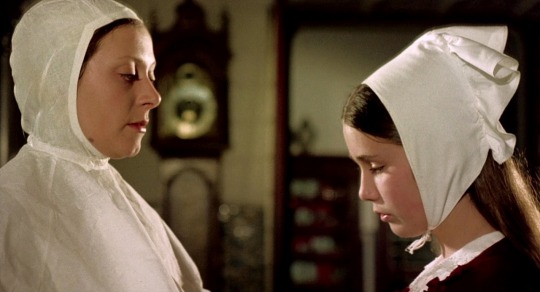




DIE LIEBESBRIEFE EINER PORTUGESISCHEN NONNE (Love letters of a Portuguese nun) (1977), directed by Jesús Franco.
10 notes
·
View notes
Photo

Love Letters of a Portuguese Nun (1977)
#Love Letters of a Portuguese Nun#Die Liebesbriefe einer portugiesischen Nonne#Jesús Franco#Jess Franco#Mariana Alcoforado#nunsploitation#Letters of a Portuguese Nun#Love Letters from a Portuguese Nun#exploitation film#exploitation#convent#nuns#nun#Inquisition-era#70s#Susan Hemingway#Franco Friday#Jess Franco Friday#Jesús Franco#gif#gifs#my gif#my gifs
25 notes
·
View notes